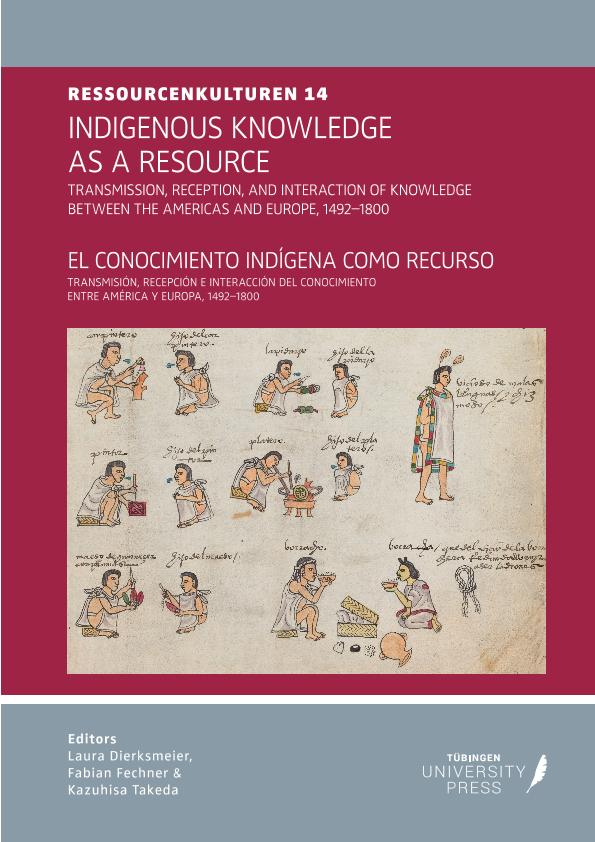Mostrar el registro sencillo del ítem
dc.contributor.author
Salinas, Maria Laura

dc.contributor.other
Dierksmeir, Laura
dc.contributor.other
Fechner, Fabián
dc.contributor.other
Takeda, Kasuhiza
dc.date.available
2022-03-22T10:34:48Z
dc.date.issued
2020
dc.identifier.citation
Salinas, Maria Laura; Entre guaraníes, caciques y frailes: El cabildo de indios del pueblo de Itatí, Río de la Plata, a fines del siglo XVIII y principios del XIX; University Tuebingen Press; 2020; 167-185
dc.identifier.isbn
978-3-947251-44-5
dc.identifier.uri
http://hdl.handle.net/11336/153704
dc.description.abstract
El tema de los cabildos de indios ha sido escasamente abordado en la historiografía del nordeste de la gobernación y posterior virreinato del Río de la Plata. Estos estudios no se han desarrollado en consonancia con la producción que sobre la cuestión existe en otros territorios (Nueva España, Venezuela, Colombia, Chile y hasta en el contexto de las Misiones Jesuíticas). Son insuficientes, también, las fuentes directas que nos han quedado sobre el funcionamiento de estas instituciones vigentes en el contexto de los pueblos de indios, quizás esta circunstancia haya influido también en el lábil estudio de esta problemática en la región.A partir de la existencia de las actas del pueblo de La Limpia y Pura Concepción de Nuestra Señora de Itatí, reducción franciscana ubicada en la región de Corrientes, gobernación del Río de la Plata, nos proponemos indagar sobre las características específicas de dicho cabildo, el rol de los cacicazgos en el funcionamiento de los mismos, como así también sobre el conocimiento indígena que se pone de manifiesto en dichas fuentes. Nos preguntamos sobre los mecanismos de negociación, de continuidad o de adaptación de las prácticas prehispánicas en el contexto de imposición de nuevas formas de poder como lasque se visualizan en este ayuntamiento indígena.
dc.description.abstract
The topic of the Indigenous town councils (cabildos) has been scarcely addressed in historio- graphy on what would become the Viceroyalty of the Río de la Plata. The development of studies has not followed the trend we observe with the pro- duction of scholarship that exists for other terri- tories (New Spain, Venezuela, Colombia, Chile and even in the context of Jesuit Missions) on the topic of Indigenous self-governance. This case study is based on the meeting minu- tes of the town of ‘La Limpia y Pura Concepción de Nuestra Señora de Itatí’, a Franciscan reduction located in the region of Corrientes, in the jurisdic- tion of the Río de la Plata. Through an analysis of the extensive and detailed meeting minutes, the specific characteristics of this town council are studied and an inquiry of the role of the cacicazgos is conducted, in addition in this process the Indi- genous knowledge is revealed. The mechanisms of negotiation and the continuity or adaptation of pre-Hispanic practices are examined in the con- text of the imposition of new forms of power such as those perceived through the primary sources of the Indigenous town council. These minutes are in themselves a testimony that generates a wealth of information. Their study will bring us closer to answering some ques- tions about the Indigenous nobility and their par- ticipation as a link between encomenderos, officials and religiosus men, the active figure in the reductions’ organisation.
dc.format
application/pdf
dc.language.iso
spa
dc.publisher
University Tuebingen Press
dc.rights
info:eu-repo/semantics/openAccess
dc.rights.uri
https://creativecommons.org/licenses/by-nc-nd/2.5/ar/
dc.subject
Cabildos
dc.subject
Indígenas
dc.subject
Saberes
dc.subject
Historia del Siglo XVIII
dc.subject
Caciques
dc.subject
Instituciones coloniales
dc.subject
Río de la Plata
dc.subject.classification
Otras Historia y Arqueología

dc.subject.classification
Historia y Arqueología

dc.subject.classification
HUMANIDADES

dc.title
Entre guaraníes, caciques y frailes: El cabildo de indios del pueblo de Itatí, Río de la Plata, a fines del siglo XVIII y principios del XIX
dc.type
info:eu-repo/semantics/publishedVersion
dc.type
info:eu-repo/semantics/bookPart
dc.type
info:ar-repo/semantics/parte de libro
dc.date.updated
2022-01-27T18:12:32Z
dc.journal.pagination
167-185
dc.journal.pais
Alemania

dc.journal.ciudad
Tübinga
dc.description.fil
Fil: Salinas, Maria Laura. Consejo Nacional de Investigaciones Científicas y Técnicas. Centro Científico Tecnológico Conicet - Nordeste. Instituto de Investigaciones Geohistóricas. Universidad Nacional del Nordeste. Instituto de Investigaciones Geohistóricas; Argentina
dc.relation.alternativeid
info:eu-repo/semantics/altIdentifier/url/https://publikationen.uni-tuebingen.de/xmlui/bitstream/handle/10900/117746/SFB1070_14_Indigenous_Knowledge.pdf?sequence=1&isAllowed=y
dc.relation.alternativeid
info:eu-repo/semantics/altIdentifier/doi/http://dx.doi.org/10.15496/publikation-59121
dc.conicet.paginas
310
dc.source.titulo
Indigenous Knowledge as a Resource: Transmission, Reception, and Interaction of Knowledge between the Americas and Europe, 1492–1800
dc.source.titulo
El conocimiento indígena como recurso: Transmisión, recepción e interacción del conocimiento entre América y Europa, 1492–1800
Archivos asociados
